Comprehensive Case Study: Osteoporosis, Fracture, Discharge Plan
VerifiedAdded on 2023/06/10
|6
|2637
|337
Case Study
AI Summary
This case study focuses on Mrs. Walker, a 60-year-old woman diagnosed with post-menopausal osteoporosis and a subsequent fracture. The solution details the pathophysiology of osteoporosis and bone fractures, including the bone healing process. It provides recommendations for health promotion, emphasizing smoking cessation, proper sleep, a balanced diet rich in calcium and vitamin D, and meditation. Ambulatory care suggestions include bisphosphonates, hormone replacement therapy, and vitamin supplements. Home care recommendations focus on skilled nursing and person-centered care. The analysis also addresses social justice considerations and the code of ethics for healthcare professionals, ensuring fair and ethical treatment. A synopsis highlights the key information for Mrs. Walker's discharge, emphasizing health promotion, ambulatory care, and home care aspects.
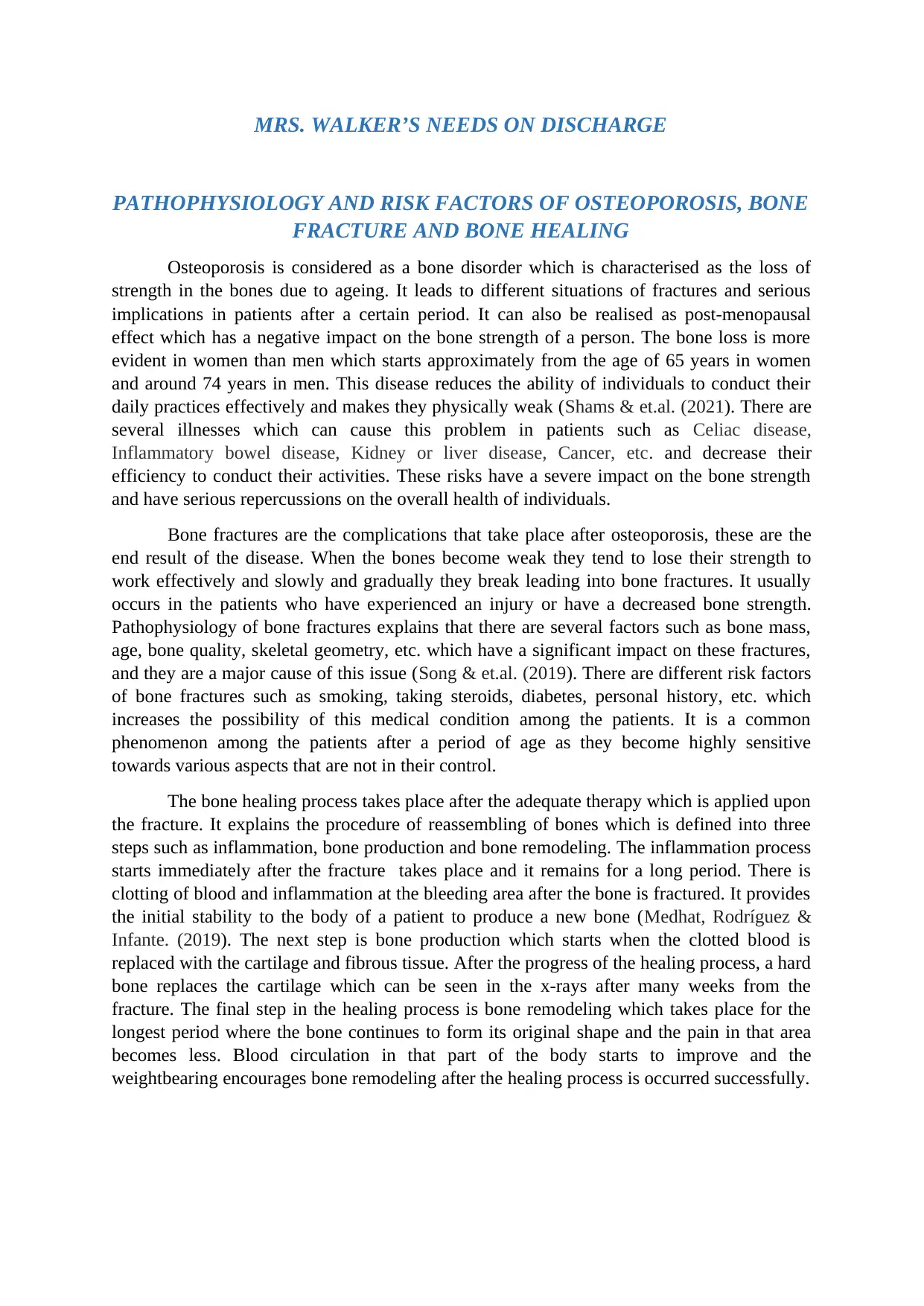
MRS. WALKER’S NEEDS ON DISCHARGE
PATHOPHYSIOLOGY AND RISK FACTORS OF OSTEOPOROSIS, BONE
FRACTURE AND BONE HEALING
Osteoporosis is considered as a bone disorder which is characterised as the loss of
strength in the bones due to ageing. It leads to different situations of fractures and serious
implications in patients after a certain period. It can also be realised as post-menopausal
effect which has a negative impact on the bone strength of a person. The bone loss is more
evident in women than men which starts approximately from the age of 65 years in women
and around 74 years in men. This disease reduces the ability of individuals to conduct their
daily practices effectively and makes they physically weak (Shams & et.al. (2021). There are
several illnesses which can cause this problem in patients such as Celiac disease,
Inflammatory bowel disease, Kidney or liver disease, Cancer, etc. and decrease their
efficiency to conduct their activities. These risks have a severe impact on the bone strength
and have serious repercussions on the overall health of individuals.
Bone fractures are the complications that take place after osteoporosis, these are the
end result of the disease. When the bones become weak they tend to lose their strength to
work effectively and slowly and gradually they break leading into bone fractures. It usually
occurs in the patients who have experienced an injury or have a decreased bone strength.
Pathophysiology of bone fractures explains that there are several factors such as bone mass,
age, bone quality, skeletal geometry, etc. which have a significant impact on these fractures,
and they are a major cause of this issue (Song & et.al. (2019). There are different risk factors
of bone fractures such as smoking, taking steroids, diabetes, personal history, etc. which
increases the possibility of this medical condition among the patients. It is a common
phenomenon among the patients after a period of age as they become highly sensitive
towards various aspects that are not in their control.
The bone healing process takes place after the adequate therapy which is applied upon
the fracture. It explains the procedure of reassembling of bones which is defined into three
steps such as inflammation, bone production and bone remodeling. The inflammation process
starts immediately after the fracture takes place and it remains for a long period. There is
clotting of blood and inflammation at the bleeding area after the bone is fractured. It provides
the initial stability to the body of a patient to produce a new bone (Medhat, Rodríguez &
Infante. (2019). The next step is bone production which starts when the clotted blood is
replaced with the cartilage and fibrous tissue. After the progress of the healing process, a hard
bone replaces the cartilage which can be seen in the x-rays after many weeks from the
fracture. The final step in the healing process is bone remodeling which takes place for the
longest period where the bone continues to form its original shape and the pain in that area
becomes less. Blood circulation in that part of the body starts to improve and the
weightbearing encourages bone remodeling after the healing process is occurred successfully.
PATHOPHYSIOLOGY AND RISK FACTORS OF OSTEOPOROSIS, BONE
FRACTURE AND BONE HEALING
Osteoporosis is considered as a bone disorder which is characterised as the loss of
strength in the bones due to ageing. It leads to different situations of fractures and serious
implications in patients after a certain period. It can also be realised as post-menopausal
effect which has a negative impact on the bone strength of a person. The bone loss is more
evident in women than men which starts approximately from the age of 65 years in women
and around 74 years in men. This disease reduces the ability of individuals to conduct their
daily practices effectively and makes they physically weak (Shams & et.al. (2021). There are
several illnesses which can cause this problem in patients such as Celiac disease,
Inflammatory bowel disease, Kidney or liver disease, Cancer, etc. and decrease their
efficiency to conduct their activities. These risks have a severe impact on the bone strength
and have serious repercussions on the overall health of individuals.
Bone fractures are the complications that take place after osteoporosis, these are the
end result of the disease. When the bones become weak they tend to lose their strength to
work effectively and slowly and gradually they break leading into bone fractures. It usually
occurs in the patients who have experienced an injury or have a decreased bone strength.
Pathophysiology of bone fractures explains that there are several factors such as bone mass,
age, bone quality, skeletal geometry, etc. which have a significant impact on these fractures,
and they are a major cause of this issue (Song & et.al. (2019). There are different risk factors
of bone fractures such as smoking, taking steroids, diabetes, personal history, etc. which
increases the possibility of this medical condition among the patients. It is a common
phenomenon among the patients after a period of age as they become highly sensitive
towards various aspects that are not in their control.
The bone healing process takes place after the adequate therapy which is applied upon
the fracture. It explains the procedure of reassembling of bones which is defined into three
steps such as inflammation, bone production and bone remodeling. The inflammation process
starts immediately after the fracture takes place and it remains for a long period. There is
clotting of blood and inflammation at the bleeding area after the bone is fractured. It provides
the initial stability to the body of a patient to produce a new bone (Medhat, Rodríguez &
Infante. (2019). The next step is bone production which starts when the clotted blood is
replaced with the cartilage and fibrous tissue. After the progress of the healing process, a hard
bone replaces the cartilage which can be seen in the x-rays after many weeks from the
fracture. The final step in the healing process is bone remodeling which takes place for the
longest period where the bone continues to form its original shape and the pain in that area
becomes less. Blood circulation in that part of the body starts to improve and the
weightbearing encourages bone remodeling after the healing process is occurred successfully.
Paraphrase This Document
Need a fresh take? Get an instant paraphrase of this document with our AI Paraphraser
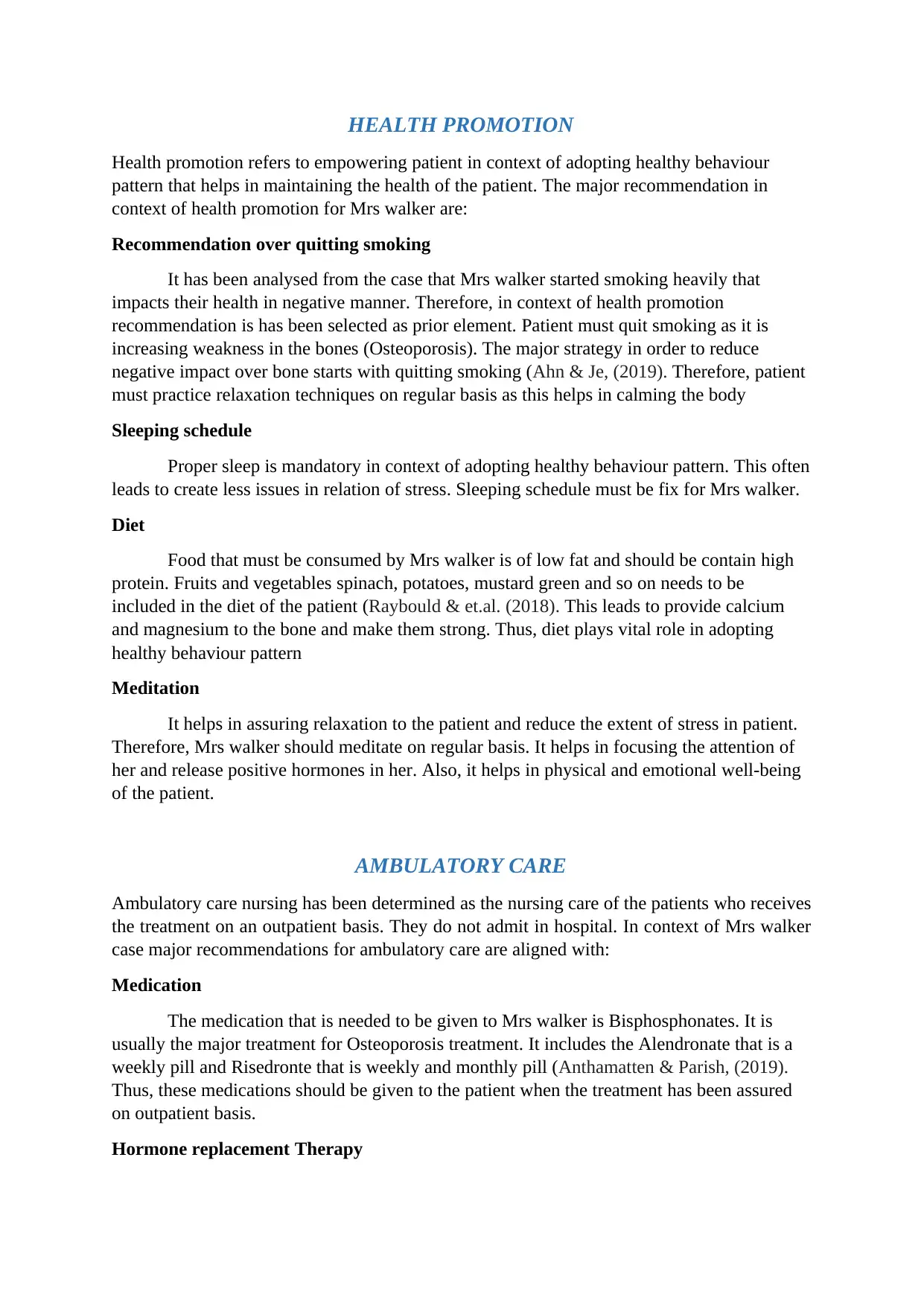
HEALTH PROMOTION
Health promotion refers to empowering patient in context of adopting healthy behaviour
pattern that helps in maintaining the health of the patient. The major recommendation in
context of health promotion for Mrs walker are:
Recommendation over quitting smoking
It has been analysed from the case that Mrs walker started smoking heavily that
impacts their health in negative manner. Therefore, in context of health promotion
recommendation is has been selected as prior element. Patient must quit smoking as it is
increasing weakness in the bones (Osteoporosis). The major strategy in order to reduce
negative impact over bone starts with quitting smoking (Ahn & Je, (2019). Therefore, patient
must practice relaxation techniques on regular basis as this helps in calming the body
Sleeping schedule
Proper sleep is mandatory in context of adopting healthy behaviour pattern. This often
leads to create less issues in relation of stress. Sleeping schedule must be fix for Mrs walker.
Diet
Food that must be consumed by Mrs walker is of low fat and should be contain high
protein. Fruits and vegetables spinach, potatoes, mustard green and so on needs to be
included in the diet of the patient (Raybould & et.al. (2018). This leads to provide calcium
and magnesium to the bone and make them strong. Thus, diet plays vital role in adopting
healthy behaviour pattern
Meditation
It helps in assuring relaxation to the patient and reduce the extent of stress in patient.
Therefore, Mrs walker should meditate on regular basis. It helps in focusing the attention of
her and release positive hormones in her. Also, it helps in physical and emotional well-being
of the patient.
AMBULATORY CARE
Ambulatory care nursing has been determined as the nursing care of the patients who receives
the treatment on an outpatient basis. They do not admit in hospital. In context of Mrs walker
case major recommendations for ambulatory care are aligned with:
Medication
The medication that is needed to be given to Mrs walker is Bisphosphonates. It is
usually the major treatment for Osteoporosis treatment. It includes the Alendronate that is a
weekly pill and Risedronte that is weekly and monthly pill (Anthamatten & Parish, (2019).
Thus, these medications should be given to the patient when the treatment has been assured
on outpatient basis.
Hormone replacement Therapy
Health promotion refers to empowering patient in context of adopting healthy behaviour
pattern that helps in maintaining the health of the patient. The major recommendation in
context of health promotion for Mrs walker are:
Recommendation over quitting smoking
It has been analysed from the case that Mrs walker started smoking heavily that
impacts their health in negative manner. Therefore, in context of health promotion
recommendation is has been selected as prior element. Patient must quit smoking as it is
increasing weakness in the bones (Osteoporosis). The major strategy in order to reduce
negative impact over bone starts with quitting smoking (Ahn & Je, (2019). Therefore, patient
must practice relaxation techniques on regular basis as this helps in calming the body
Sleeping schedule
Proper sleep is mandatory in context of adopting healthy behaviour pattern. This often
leads to create less issues in relation of stress. Sleeping schedule must be fix for Mrs walker.
Diet
Food that must be consumed by Mrs walker is of low fat and should be contain high
protein. Fruits and vegetables spinach, potatoes, mustard green and so on needs to be
included in the diet of the patient (Raybould & et.al. (2018). This leads to provide calcium
and magnesium to the bone and make them strong. Thus, diet plays vital role in adopting
healthy behaviour pattern
Meditation
It helps in assuring relaxation to the patient and reduce the extent of stress in patient.
Therefore, Mrs walker should meditate on regular basis. It helps in focusing the attention of
her and release positive hormones in her. Also, it helps in physical and emotional well-being
of the patient.
AMBULATORY CARE
Ambulatory care nursing has been determined as the nursing care of the patients who receives
the treatment on an outpatient basis. They do not admit in hospital. In context of Mrs walker
case major recommendations for ambulatory care are aligned with:
Medication
The medication that is needed to be given to Mrs walker is Bisphosphonates. It is
usually the major treatment for Osteoporosis treatment. It includes the Alendronate that is a
weekly pill and Risedronte that is weekly and monthly pill (Anthamatten & Parish, (2019).
Thus, these medications should be given to the patient when the treatment has been assured
on outpatient basis.
Hormone replacement Therapy
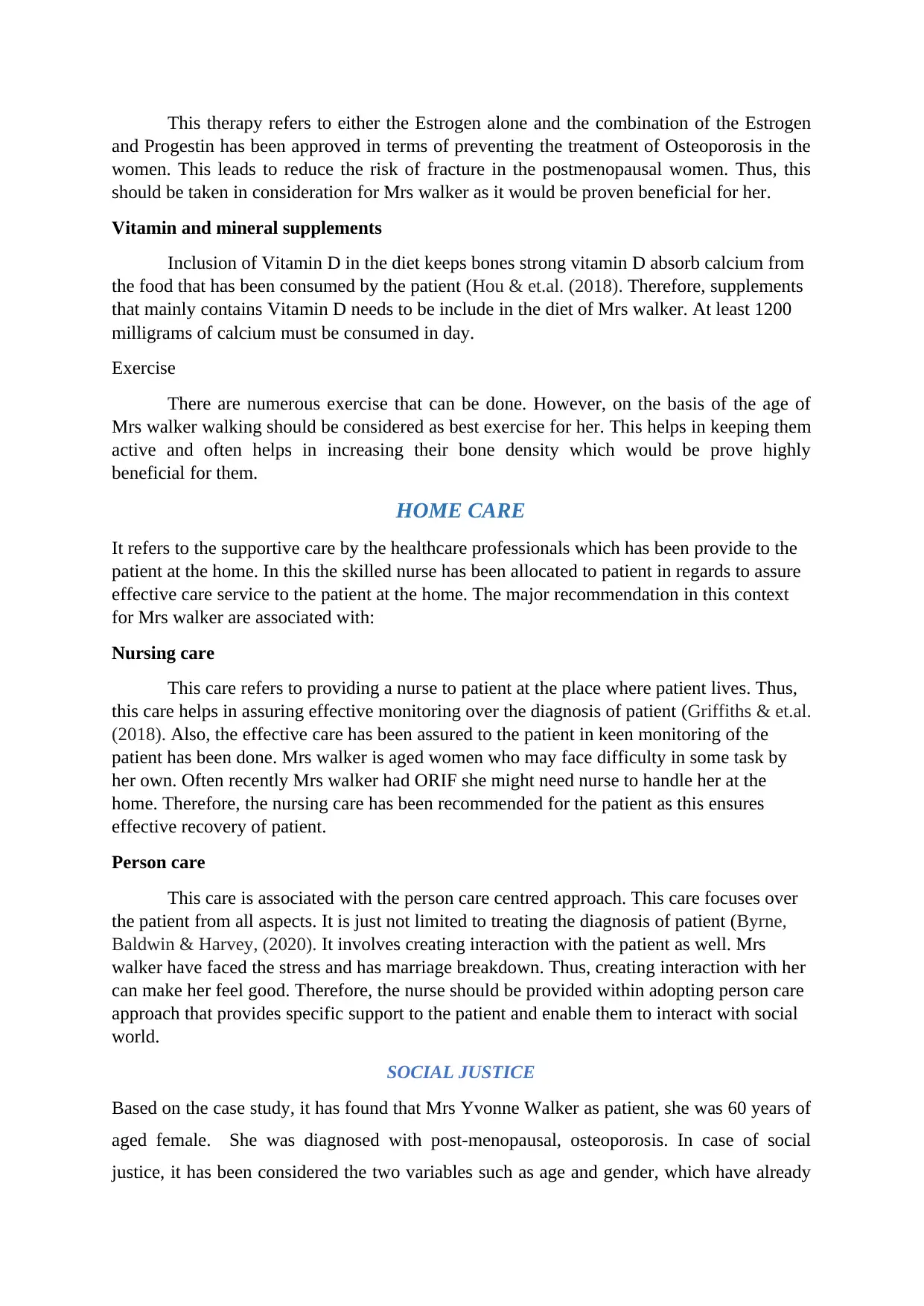
This therapy refers to either the Estrogen alone and the combination of the Estrogen
and Progestin has been approved in terms of preventing the treatment of Osteoporosis in the
women. This leads to reduce the risk of fracture in the postmenopausal women. Thus, this
should be taken in consideration for Mrs walker as it would be proven beneficial for her.
Vitamin and mineral supplements
Inclusion of Vitamin D in the diet keeps bones strong vitamin D absorb calcium from
the food that has been consumed by the patient (Hou & et.al. (2018). Therefore, supplements
that mainly contains Vitamin D needs to be include in the diet of Mrs walker. At least 1200
milligrams of calcium must be consumed in day.
Exercise
There are numerous exercise that can be done. However, on the basis of the age of
Mrs walker walking should be considered as best exercise for her. This helps in keeping them
active and often helps in increasing their bone density which would be prove highly
beneficial for them.
HOME CARE
It refers to the supportive care by the healthcare professionals which has been provide to the
patient at the home. In this the skilled nurse has been allocated to patient in regards to assure
effective care service to the patient at the home. The major recommendation in this context
for Mrs walker are associated with:
Nursing care
This care refers to providing a nurse to patient at the place where patient lives. Thus,
this care helps in assuring effective monitoring over the diagnosis of patient (Griffiths & et.al.
(2018). Also, the effective care has been assured to the patient in keen monitoring of the
patient has been done. Mrs walker is aged women who may face difficulty in some task by
her own. Often recently Mrs walker had ORIF she might need nurse to handle her at the
home. Therefore, the nursing care has been recommended for the patient as this ensures
effective recovery of patient.
Person care
This care is associated with the person care centred approach. This care focuses over
the patient from all aspects. It is just not limited to treating the diagnosis of patient (Byrne,
Baldwin & Harvey, (2020). It involves creating interaction with the patient as well. Mrs
walker have faced the stress and has marriage breakdown. Thus, creating interaction with her
can make her feel good. Therefore, the nurse should be provided within adopting person care
approach that provides specific support to the patient and enable them to interact with social
world.
SOCIAL JUSTICE
Based on the case study, it has found that Mrs Yvonne Walker as patient, she was 60 years of
aged female. She was diagnosed with post-menopausal, osteoporosis. In case of social
justice, it has been considered the two variables such as age and gender, which have already
and Progestin has been approved in terms of preventing the treatment of Osteoporosis in the
women. This leads to reduce the risk of fracture in the postmenopausal women. Thus, this
should be taken in consideration for Mrs walker as it would be proven beneficial for her.
Vitamin and mineral supplements
Inclusion of Vitamin D in the diet keeps bones strong vitamin D absorb calcium from
the food that has been consumed by the patient (Hou & et.al. (2018). Therefore, supplements
that mainly contains Vitamin D needs to be include in the diet of Mrs walker. At least 1200
milligrams of calcium must be consumed in day.
Exercise
There are numerous exercise that can be done. However, on the basis of the age of
Mrs walker walking should be considered as best exercise for her. This helps in keeping them
active and often helps in increasing their bone density which would be prove highly
beneficial for them.
HOME CARE
It refers to the supportive care by the healthcare professionals which has been provide to the
patient at the home. In this the skilled nurse has been allocated to patient in regards to assure
effective care service to the patient at the home. The major recommendation in this context
for Mrs walker are associated with:
Nursing care
This care refers to providing a nurse to patient at the place where patient lives. Thus,
this care helps in assuring effective monitoring over the diagnosis of patient (Griffiths & et.al.
(2018). Also, the effective care has been assured to the patient in keen monitoring of the
patient has been done. Mrs walker is aged women who may face difficulty in some task by
her own. Often recently Mrs walker had ORIF she might need nurse to handle her at the
home. Therefore, the nursing care has been recommended for the patient as this ensures
effective recovery of patient.
Person care
This care is associated with the person care centred approach. This care focuses over
the patient from all aspects. It is just not limited to treating the diagnosis of patient (Byrne,
Baldwin & Harvey, (2020). It involves creating interaction with the patient as well. Mrs
walker have faced the stress and has marriage breakdown. Thus, creating interaction with her
can make her feel good. Therefore, the nurse should be provided within adopting person care
approach that provides specific support to the patient and enable them to interact with social
world.
SOCIAL JUSTICE
Based on the case study, it has found that Mrs Yvonne Walker as patient, she was 60 years of
aged female. She was diagnosed with post-menopausal, osteoporosis. In case of social
justice, it has been considered the two variables such as age and gender, which have already
⊘ This is a preview!⊘
Do you want full access?
Subscribe today to unlock all pages.

Trusted by 1+ million students worldwide
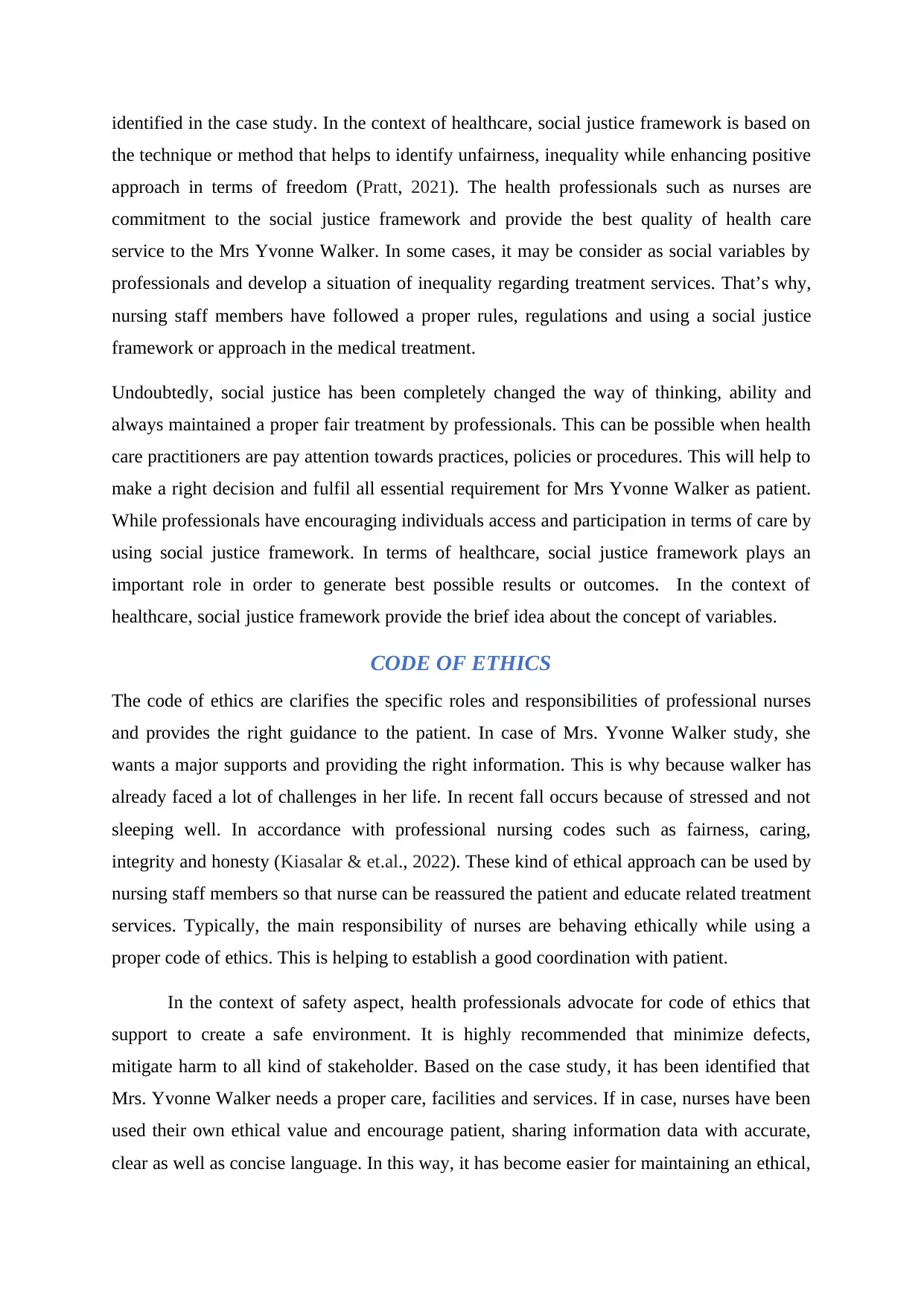
identified in the case study. In the context of healthcare, social justice framework is based on
the technique or method that helps to identify unfairness, inequality while enhancing positive
approach in terms of freedom (Pratt, 2021). The health professionals such as nurses are
commitment to the social justice framework and provide the best quality of health care
service to the Mrs Yvonne Walker. In some cases, it may be consider as social variables by
professionals and develop a situation of inequality regarding treatment services. That’s why,
nursing staff members have followed a proper rules, regulations and using a social justice
framework or approach in the medical treatment.
Undoubtedly, social justice has been completely changed the way of thinking, ability and
always maintained a proper fair treatment by professionals. This can be possible when health
care practitioners are pay attention towards practices, policies or procedures. This will help to
make a right decision and fulfil all essential requirement for Mrs Yvonne Walker as patient.
While professionals have encouraging individuals access and participation in terms of care by
using social justice framework. In terms of healthcare, social justice framework plays an
important role in order to generate best possible results or outcomes. In the context of
healthcare, social justice framework provide the brief idea about the concept of variables.
CODE OF ETHICS
The code of ethics are clarifies the specific roles and responsibilities of professional nurses
and provides the right guidance to the patient. In case of Mrs. Yvonne Walker study, she
wants a major supports and providing the right information. This is why because walker has
already faced a lot of challenges in her life. In recent fall occurs because of stressed and not
sleeping well. In accordance with professional nursing codes such as fairness, caring,
integrity and honesty (Kiasalar & et.al., 2022). These kind of ethical approach can be used by
nursing staff members so that nurse can be reassured the patient and educate related treatment
services. Typically, the main responsibility of nurses are behaving ethically while using a
proper code of ethics. This is helping to establish a good coordination with patient.
In the context of safety aspect, health professionals advocate for code of ethics that
support to create a safe environment. It is highly recommended that minimize defects,
mitigate harm to all kind of stakeholder. Based on the case study, it has been identified that
Mrs. Yvonne Walker needs a proper care, facilities and services. If in case, nurses have been
used their own ethical value and encourage patient, sharing information data with accurate,
clear as well as concise language. In this way, it has become easier for maintaining an ethical,
the technique or method that helps to identify unfairness, inequality while enhancing positive
approach in terms of freedom (Pratt, 2021). The health professionals such as nurses are
commitment to the social justice framework and provide the best quality of health care
service to the Mrs Yvonne Walker. In some cases, it may be consider as social variables by
professionals and develop a situation of inequality regarding treatment services. That’s why,
nursing staff members have followed a proper rules, regulations and using a social justice
framework or approach in the medical treatment.
Undoubtedly, social justice has been completely changed the way of thinking, ability and
always maintained a proper fair treatment by professionals. This can be possible when health
care practitioners are pay attention towards practices, policies or procedures. This will help to
make a right decision and fulfil all essential requirement for Mrs Yvonne Walker as patient.
While professionals have encouraging individuals access and participation in terms of care by
using social justice framework. In terms of healthcare, social justice framework plays an
important role in order to generate best possible results or outcomes. In the context of
healthcare, social justice framework provide the brief idea about the concept of variables.
CODE OF ETHICS
The code of ethics are clarifies the specific roles and responsibilities of professional nurses
and provides the right guidance to the patient. In case of Mrs. Yvonne Walker study, she
wants a major supports and providing the right information. This is why because walker has
already faced a lot of challenges in her life. In recent fall occurs because of stressed and not
sleeping well. In accordance with professional nursing codes such as fairness, caring,
integrity and honesty (Kiasalar & et.al., 2022). These kind of ethical approach can be used by
nursing staff members so that nurse can be reassured the patient and educate related treatment
services. Typically, the main responsibility of nurses are behaving ethically while using a
proper code of ethics. This is helping to establish a good coordination with patient.
In the context of safety aspect, health professionals advocate for code of ethics that
support to create a safe environment. It is highly recommended that minimize defects,
mitigate harm to all kind of stakeholder. Based on the case study, it has been identified that
Mrs. Yvonne Walker needs a proper care, facilities and services. If in case, nurses have been
used their own ethical value and encourage patient, sharing information data with accurate,
clear as well as concise language. In this way, it has become easier for maintaining an ethical,
Paraphrase This Document
Need a fresh take? Get an instant paraphrase of this document with our AI Paraphraser
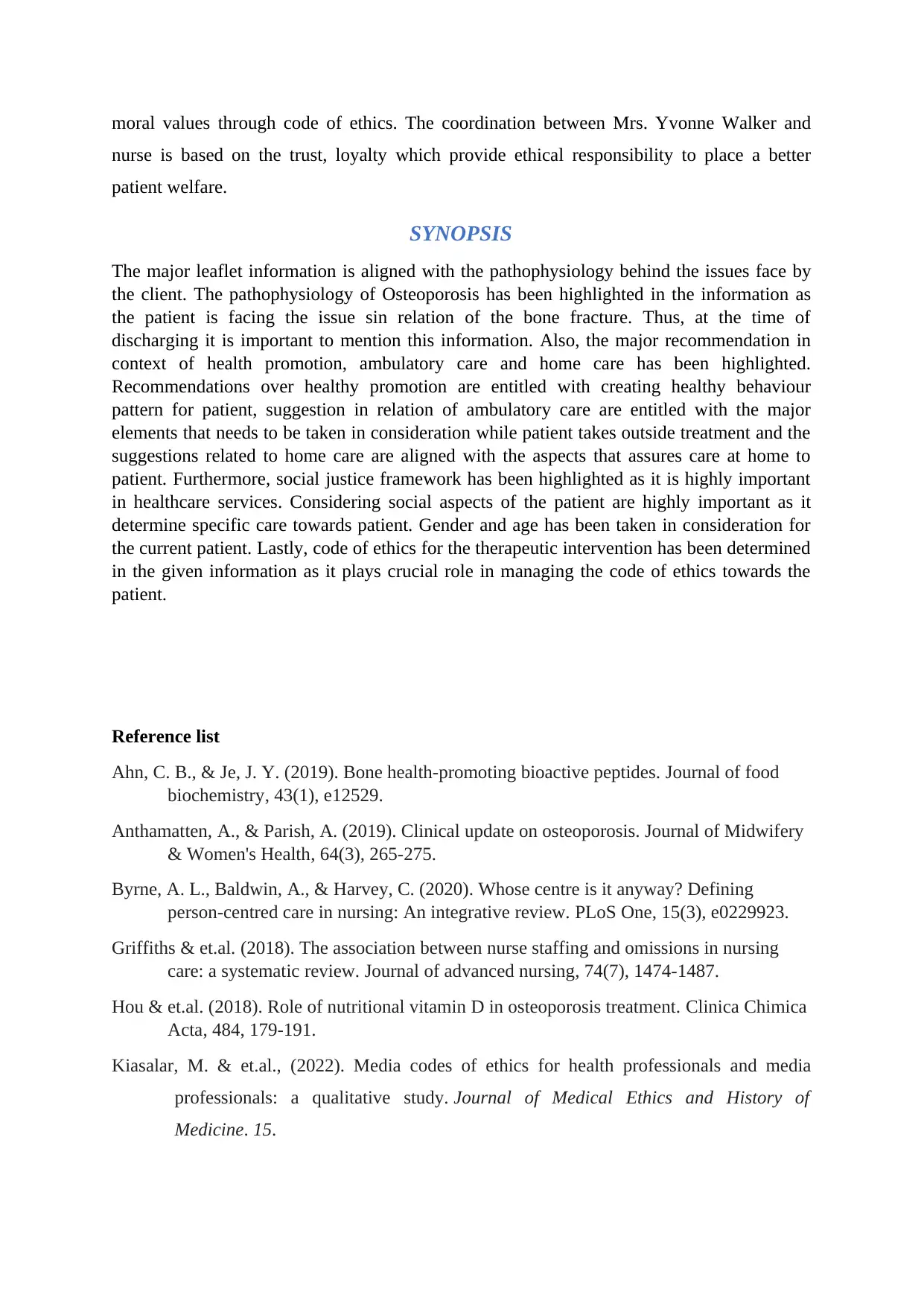
moral values through code of ethics. The coordination between Mrs. Yvonne Walker and
nurse is based on the trust, loyalty which provide ethical responsibility to place a better
patient welfare.
SYNOPSIS
The major leaflet information is aligned with the pathophysiology behind the issues face by
the client. The pathophysiology of Osteoporosis has been highlighted in the information as
the patient is facing the issue sin relation of the bone fracture. Thus, at the time of
discharging it is important to mention this information. Also, the major recommendation in
context of health promotion, ambulatory care and home care has been highlighted.
Recommendations over healthy promotion are entitled with creating healthy behaviour
pattern for patient, suggestion in relation of ambulatory care are entitled with the major
elements that needs to be taken in consideration while patient takes outside treatment and the
suggestions related to home care are aligned with the aspects that assures care at home to
patient. Furthermore, social justice framework has been highlighted as it is highly important
in healthcare services. Considering social aspects of the patient are highly important as it
determine specific care towards patient. Gender and age has been taken in consideration for
the current patient. Lastly, code of ethics for the therapeutic intervention has been determined
in the given information as it plays crucial role in managing the code of ethics towards the
patient.
Reference list
Ahn, C. B., & Je, J. Y. (2019). Bone health‐promoting bioactive peptides. Journal of food
biochemistry, 43(1), e12529.
Anthamatten, A., & Parish, A. (2019). Clinical update on osteoporosis. Journal of Midwifery
& Women's Health, 64(3), 265-275.
Byrne, A. L., Baldwin, A., & Harvey, C. (2020). Whose centre is it anyway? Defining
person-centred care in nursing: An integrative review. PLoS One, 15(3), e0229923.
Griffiths & et.al. (2018). The association between nurse staffing and omissions in nursing
care: a systematic review. Journal of advanced nursing, 74(7), 1474-1487.
Hou & et.al. (2018). Role of nutritional vitamin D in osteoporosis treatment. Clinica Chimica
Acta, 484, 179-191.
Kiasalar, M. & et.al., (2022). Media codes of ethics for health professionals and media
professionals: a qualitative study. Journal of Medical Ethics and History of
Medicine. 15.
nurse is based on the trust, loyalty which provide ethical responsibility to place a better
patient welfare.
SYNOPSIS
The major leaflet information is aligned with the pathophysiology behind the issues face by
the client. The pathophysiology of Osteoporosis has been highlighted in the information as
the patient is facing the issue sin relation of the bone fracture. Thus, at the time of
discharging it is important to mention this information. Also, the major recommendation in
context of health promotion, ambulatory care and home care has been highlighted.
Recommendations over healthy promotion are entitled with creating healthy behaviour
pattern for patient, suggestion in relation of ambulatory care are entitled with the major
elements that needs to be taken in consideration while patient takes outside treatment and the
suggestions related to home care are aligned with the aspects that assures care at home to
patient. Furthermore, social justice framework has been highlighted as it is highly important
in healthcare services. Considering social aspects of the patient are highly important as it
determine specific care towards patient. Gender and age has been taken in consideration for
the current patient. Lastly, code of ethics for the therapeutic intervention has been determined
in the given information as it plays crucial role in managing the code of ethics towards the
patient.
Reference list
Ahn, C. B., & Je, J. Y. (2019). Bone health‐promoting bioactive peptides. Journal of food
biochemistry, 43(1), e12529.
Anthamatten, A., & Parish, A. (2019). Clinical update on osteoporosis. Journal of Midwifery
& Women's Health, 64(3), 265-275.
Byrne, A. L., Baldwin, A., & Harvey, C. (2020). Whose centre is it anyway? Defining
person-centred care in nursing: An integrative review. PLoS One, 15(3), e0229923.
Griffiths & et.al. (2018). The association between nurse staffing and omissions in nursing
care: a systematic review. Journal of advanced nursing, 74(7), 1474-1487.
Hou & et.al. (2018). Role of nutritional vitamin D in osteoporosis treatment. Clinica Chimica
Acta, 484, 179-191.
Kiasalar, M. & et.al., (2022). Media codes of ethics for health professionals and media
professionals: a qualitative study. Journal of Medical Ethics and History of
Medicine. 15.
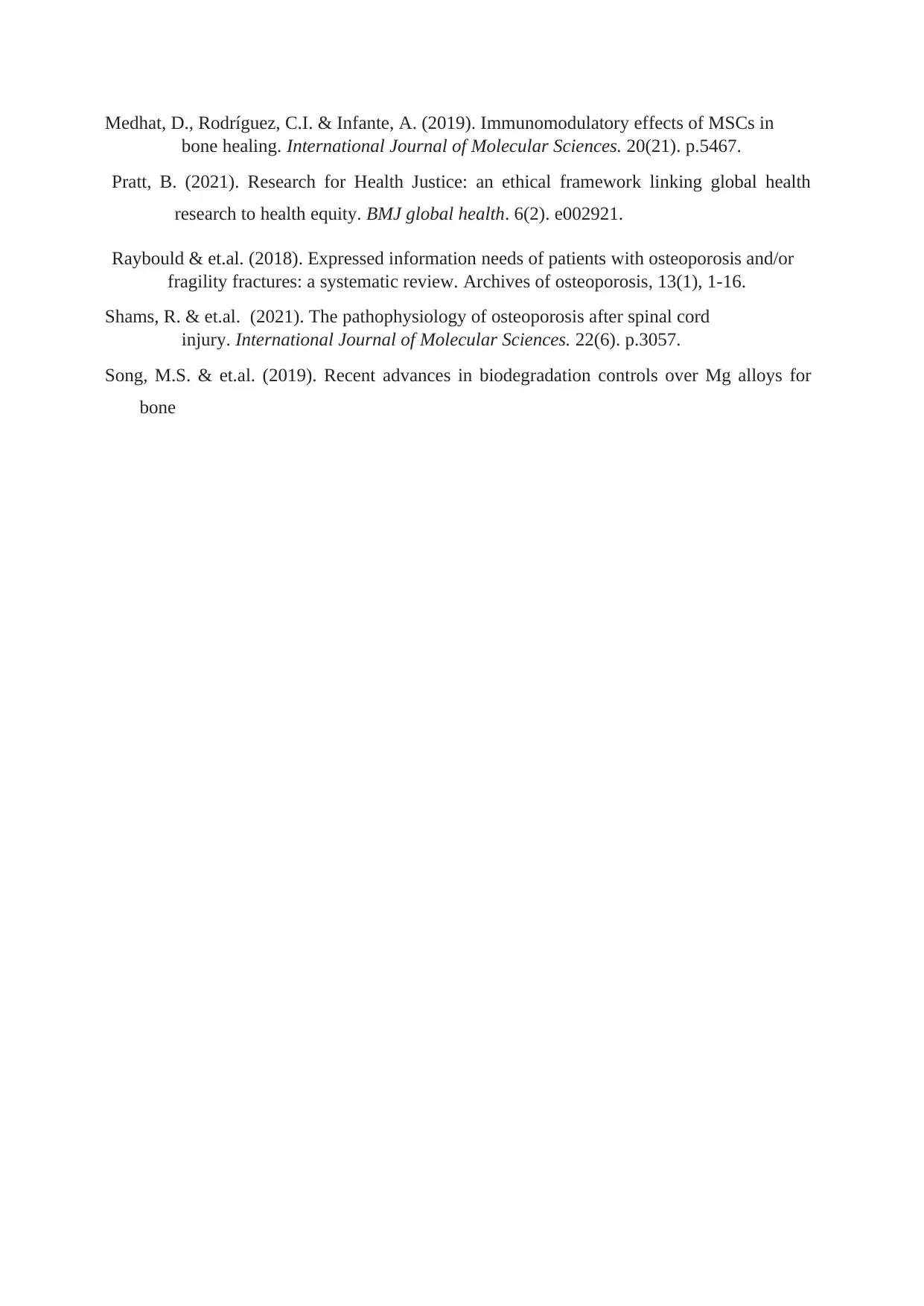
Medhat, D., Rodríguez, C.I. & Infante, A. (2019). Immunomodulatory effects of MSCs in
bone healing. International Journal of Molecular Sciences. 20(21). p.5467.
Pratt, B. (2021). Research for Health Justice: an ethical framework linking global health
research to health equity. BMJ global health. 6(2). e002921.
Raybould & et.al. (2018). Expressed information needs of patients with osteoporosis and/or
fragility fractures: a systematic review. Archives of osteoporosis, 13(1), 1-16.
Shams, R. & et.al. (2021). The pathophysiology of osteoporosis after spinal cord
injury. International Journal of Molecular Sciences. 22(6). p.3057.
Song, M.S. & et.al. (2019). Recent advances in biodegradation controls over Mg alloys for
bone
bone healing. International Journal of Molecular Sciences. 20(21). p.5467.
Pratt, B. (2021). Research for Health Justice: an ethical framework linking global health
research to health equity. BMJ global health. 6(2). e002921.
Raybould & et.al. (2018). Expressed information needs of patients with osteoporosis and/or
fragility fractures: a systematic review. Archives of osteoporosis, 13(1), 1-16.
Shams, R. & et.al. (2021). The pathophysiology of osteoporosis after spinal cord
injury. International Journal of Molecular Sciences. 22(6). p.3057.
Song, M.S. & et.al. (2019). Recent advances in biodegradation controls over Mg alloys for
bone
⊘ This is a preview!⊘
Do you want full access?
Subscribe today to unlock all pages.

Trusted by 1+ million students worldwide
1 out of 6
Related Documents
Your All-in-One AI-Powered Toolkit for Academic Success.
+13062052269
info@desklib.com
Available 24*7 on WhatsApp / Email
![[object Object]](/_next/static/media/star-bottom.7253800d.svg)
Unlock your academic potential
Copyright © 2020–2025 A2Z Services. All Rights Reserved. Developed and managed by ZUCOL.





